For a little while it has seemed all the development and innovation in e-bike mid drives has been with the big name OEM (original equipment manufacturer) suppliers. Little has changed in the after market world for ages. And that’s been a pity for those interested in having e-assist on their bikes and trikes that are not in the main stream.
The landscape has changed recently with the release of the CYC Motor’s Photon model. Much like the ubiquitous Bafang BBS series, the Photon is a simple retrofit e-assist system that fits a standard (and some times not so standard) bottom bracket shell.
The big news is that the Photos is a torque sensing system rather than the cadence sensing of the Bafang BBS. Which one is better? Stay with me and we’ll see…
The Photon motor
Firstly an overview of the Photon.
With a total weight of 4.kg it is much the same as the BBS, but looks smaller and more compact. Accepting input voltages between 36 and 52 volt, the motor is rated at 750 watt and 110Nm torque with a maximum crank RPM of 300. Peak wattage is much higher than the 750 watt rating.
The motor can be software limited to whatever power you might like, so having a road legal 250 watt system is entirely possible.
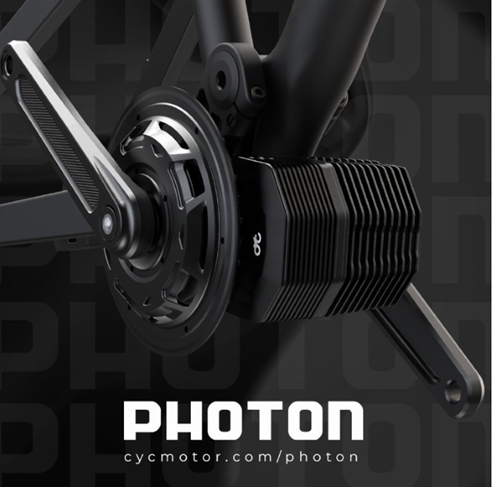
Our test unit was kindly supplied by Cap Rouge, suppliers of e-bike batteries, chargers and aftermarket motors. We installed it to our Performer Futuro delta trike for the test period before retuning the motor to Cap Rouge.
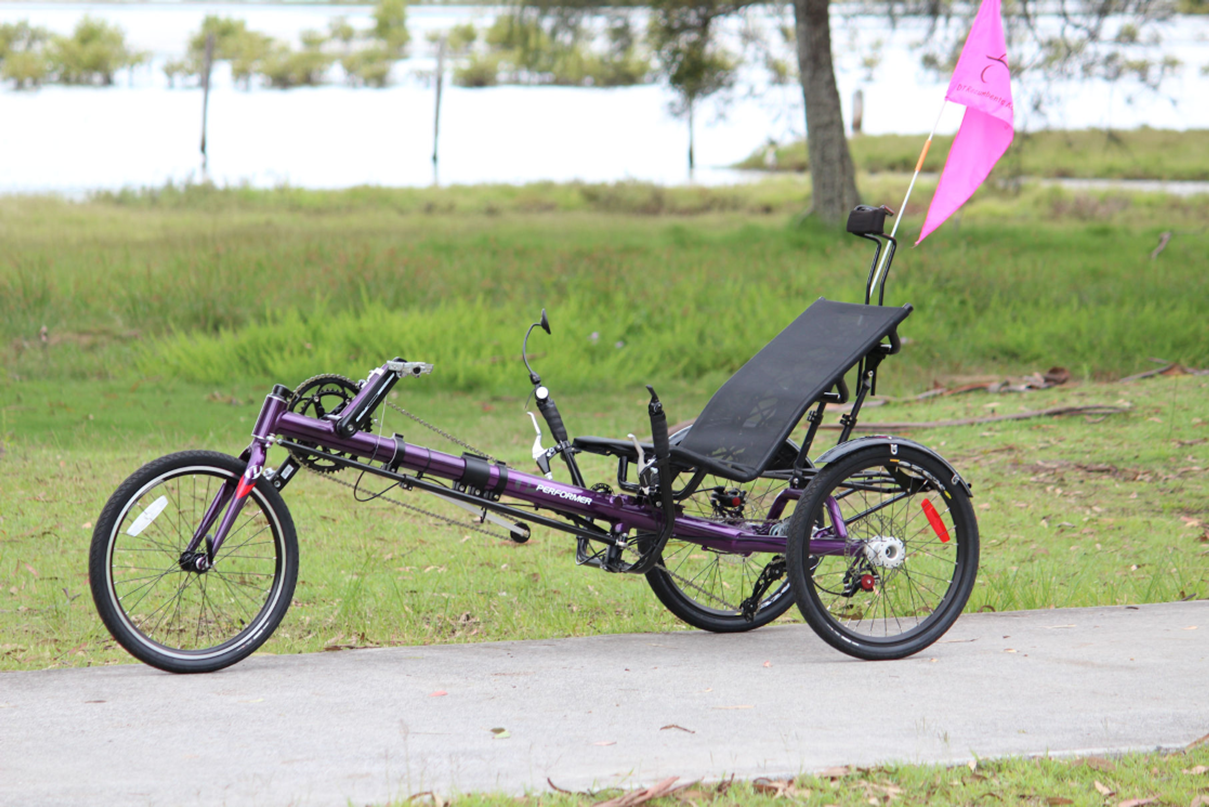
Installation and Initial Setup
Installing a mid drive intended for an upright bike is rarely straight forward when fitting to a recumbent. The CYC Motors kit is no exception. Fortunately the Futuro was a good choice for this test as the bottom bracket is conveniently close to the front wheel for mounting the speed sensor. Installation onto a tadpole trike would be problematic as wiring extensions are not yet available in Australia.
The included DS103 colour display has the keypad control on a short fly lead, convenient for an upright bike but not so much for the typical recumbent. We mounted the display on the derailleur post, and fitted the keypad alongside. CYC have thoughtfully included different sized handle bar clamps for mounting the display and the finished install is neat.
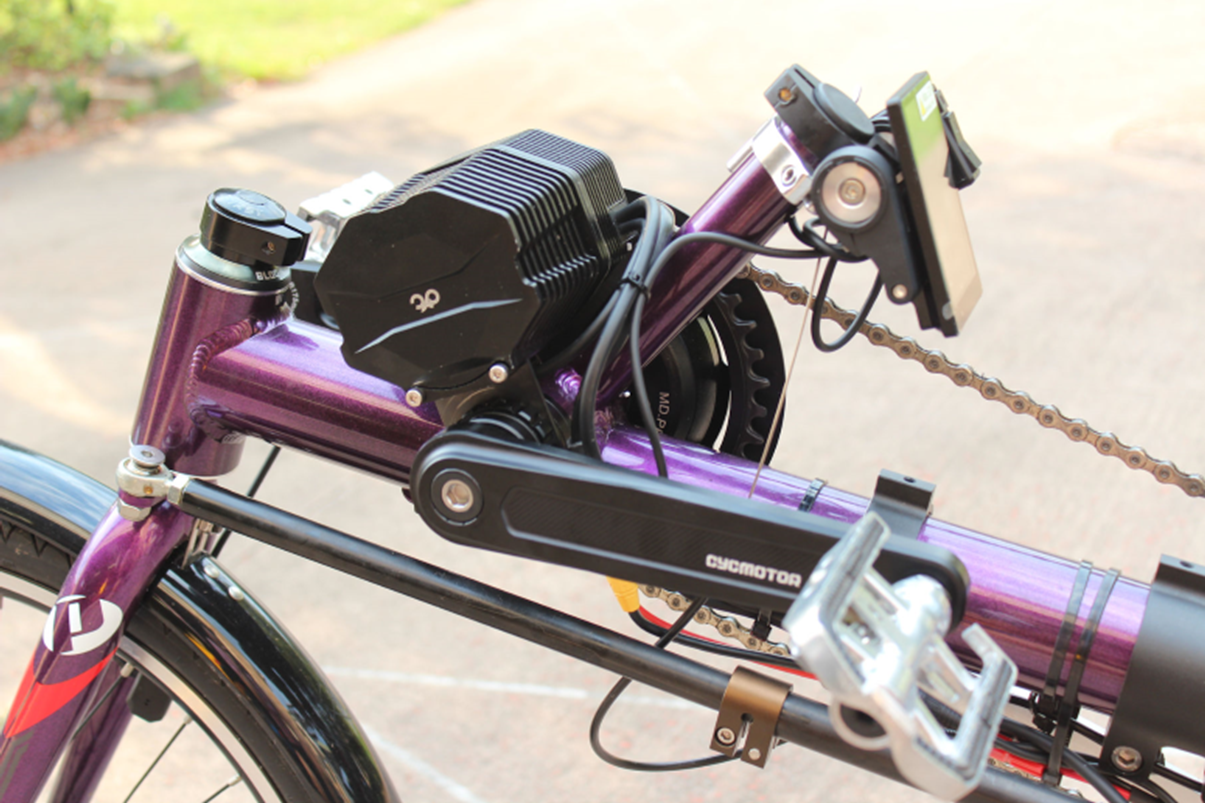
Our battery to hand was a 36V10Ah rectangle. The motor seemed perfectly happy with this.
Day to day operation of the system is typical of e-bikes – push and hold the on/off button and the display springs to life, defaulting to level 0 on the scale.
Setup is best done using the CYC app and a smart phone via the integrated Bluetooth connection. Depending on how technically adept you are, this can be a breeze, or mighty frustrating.
The phone app doesn’t have a help menu built in, and some of the settings are not intuitive.
The downloadable manual is much better and with a printed copy in one hand and smartphone in the other progress was much smoother.
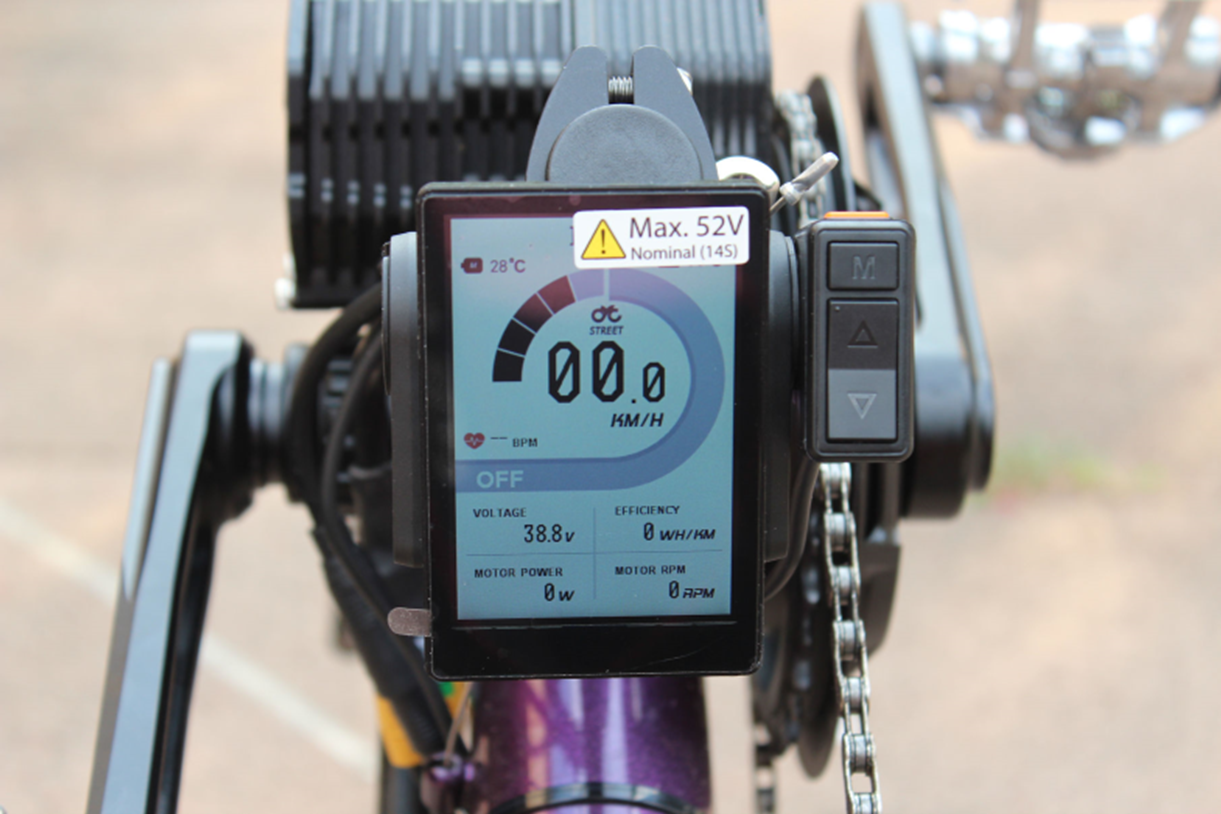
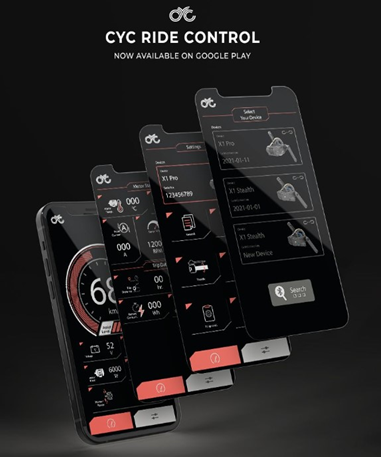
Getting the Setup right
Our Photon came with a 38T chainring. Coupled with the trike’s 20” wheels the overall gearing is quite low, and this together with the default power settings gave quite a negative impression on first ride.
Why? Well it goes something like this…
Stationary, first gear selected and level 1 on the e-kit. First pedal stroke and the motor says beauty, add power and does – the default percentage of the standard 750 watt – and the resulting acceleration is breathtaking although short, as within one pedal rotation we’re going faster than I can pedal this gear, resulting in the applied torque dropping to zero and the motor stops. Change up a gear or two and repeat. Hmm, not comfortable at all.
Back into the workshop to look further into the settings, accessed via the CYC Ride Control phone app using a Bluetooth connection.
Now this is one of the good things about the Photon – the ability to change the way the motor behaves. It’s probably also a bad thing as it would be quite possible to make it nearly unrideable by choosing the wrong combination of settings. The software has several performance profiles as standard: “Street” and “Race” with race being essentially unlimited, and the “Street” having options of USA, EU, Canada, and unrestricted. There is not a default setting for Australia. Within these profiles there are lots of settings for power, torque, speed, and so on.
Adjusting the power settings down to a more sensible (and I might add legal) number, and with level 1 and 2 set at a percentage of the legal maximum yielded a far more pleasant ride. The trike responded to pedal input as normal, except that now I felt like I had superman’s legs instead (ie super strong!).
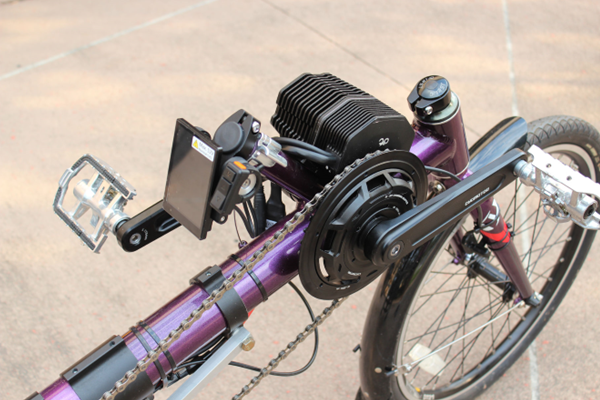
Riding it
Perhaps the most striking thing is the motor’s ability to apply power in response to pressure on the pedal without actually turning the cranks. Think uphill starts – push on the pedal and you get instant power to start moving. Wonderful. (For safety there is a minimum torque below which the motor won’t engage.)
The ride experience is, well, just like pedaling a bike. Being torque based, it requires active rider input – no phantom pedaling allowed here! Level 1 on the assist scale was more than adequate during our rides (our settings had level 1 at 100 watts, level 2 180 watts, and level 3 the full 250 watts), while level 3 demolished hills.
The speed limit for assist is very noticeable. Reach 25kmh and the motor shuts down. Then it’s human power all the way until speed drops below the magic 25, whereupon the motor re-engages. The 38T chainring and the trikes’ gearing meant top speed human-powered was just shy of 30kmh (depending how fast you can pedal), and there was still a useful low gear to get you home without motor if needed.
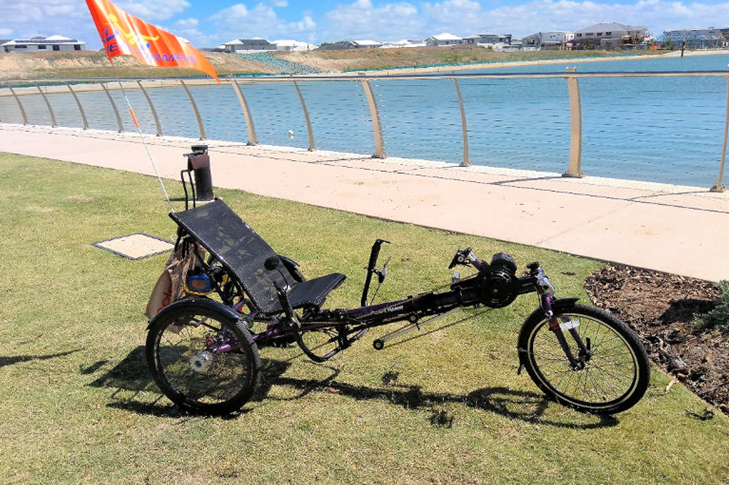
Downsides..
This all sounds fine and beaut. Surely there are some downsides.
Well of course there are, and depending on one’s personal situation they could be deal breakers. Interestingly enough, none of the drawbacks are related to the actual operation of the motor.
First up there are some hardware limitations. There are limited chainring choices available. Presently only a 34, 38 or 50T chainrings are on offer. They are specials for the CYC motor too, so no grabbing one from the local bike shop.
The “Q” factor (the distance between the left & right pedals) is wide. Like 200mm wide. It’s probably not an issue for most people, but if you were thinking of fitting this to the nose of your slim velomobile then it’s likely a problem.
Presently the wiring supplied is not suitable for the average recumbent trike. A neat and practical installation is going to need the wiring cut and extended (well at least until the factory produces extension leads), and that could well impact on warranty claims.
Legality
This could be a big one. From factory, the motor is rated at 750 watts, and capable of 2000 watt if desired. And while it is easy to set the power to 250W, it is just as easy to remove all limitations. I would not like to be the person trying to prove compliance with the legal requirements. To be fair, this also applies to the Bafang BBS series, although Bafang do sell models where the power set within the firmware and engraved on the outside.
Our understanding is that dealers will be able to access the motor’s firmware and set the power limits to comply with Australia’s e-bike laws.
Conclusion…..
Did we like it? Yes!
Is it better than a Bafang? Perhaps.
The Photon is beautifully made and finished, and shows a lot of thought has gone into the design and construction. Time will tell if lasts as well as it looks, but everything we have seen points to it being a quality product. It has a lot of features we like, but it does come at a price premium over the Bafang BBS motors. (Check out Cap Rouge for pricing.)
Astute readers will notice I have not mentioned the Tong Shen TSDZ2 torque sensing mid drive. This is purely because I have no direct personal experience with the TSDZ2 system. If you are looking for a torque sensing mid drive at a more competitive price point, it’s worth investigating.
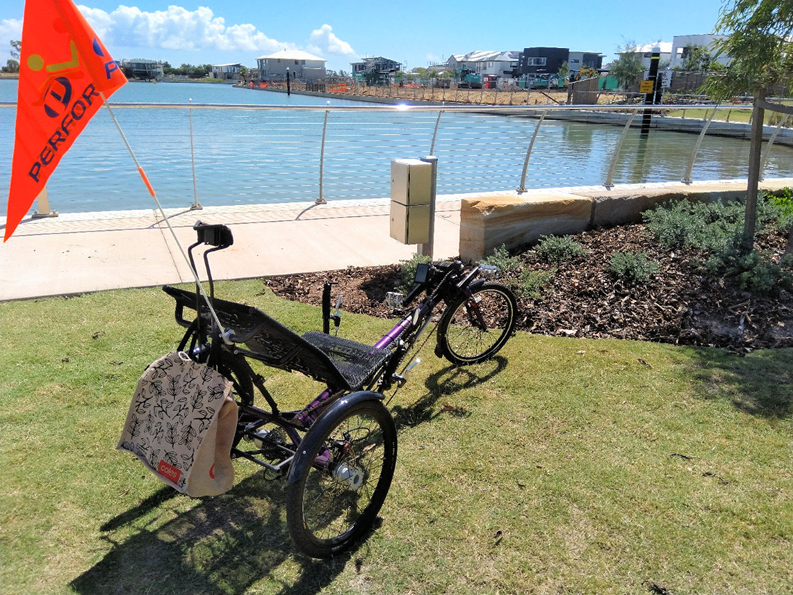

I find riding a BBSHD over 50 km rides where there is little traffic, I can let fly and my average speed was recently 34kph in the Tour de Brisbane and that was contending with 8000 other cyclists all going somewhat slower. The consequence of my type of riding is that the small 11T cog gets ALL THE WEAR and needs replacing twice as often even using a 65T chainring. My ideal size of chainring would be about 70-80T but failing that, how can I arrange my running gear so that the other cassette sizes get used more often and wear is evened out? The power of the BBSHD is so great that all gears with the exception of 11T are superfluous except for going up steep hills.
There needs to be more R & D investigation on combining mid drive motors with recumbent trikes and that can only happen when authorities acknowledge that a 25kph restriction is outdated and unnecessary provided riders have a current drivers license.
The mid-drive manufacturers I’m sure respond to whatever the legal framework is in their markets, I’d suggest you contact your local Member of Parliament regarding your thoughts on the present e-bike laws.
The CYC 750W engine sounds great especially combined with a 50T chainring and able to be programmed to perform as desired via a phone app. Ie, in graduated increases over the Pedal Assist range. The drawback seems to be a lack of extensions required by recumbents generally. I wonder if communications with the manufacturers is any better than the woeful ones on offer from Bafang?
One good idea from Bafang is the TWO MODES of settings available via the EGGRIDER display. One for ROADS and one for OFFROADS. I don’t know how long this might fool our local police but, it only takes one push of a button to change from one to the other?
The CYC Photon offers two selectable modes of operation via the phone app.
The legality of this has not been tried in court as far as I am aware.